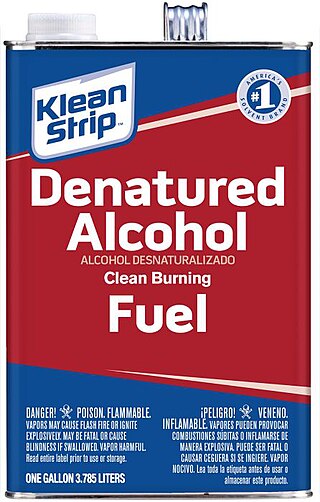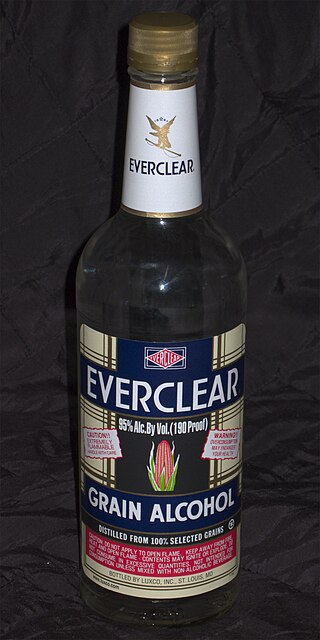
Ethanol is an organic compound with the chemical formula CH3CH2OH. It is an alcohol, with its formula also written as C2H5OH, C2H6O or EtOH, where Et stands for ethyl. Ethanol is a volatile, flammable, colorless liquid with a characteristic wine-like odor and pungent taste. It is a psychoactive recreational drug, and the active ingredient in alcoholic drinks.

Listerine is a brand of antiseptic mouthwash that is promoted with the slogan "Kills germs that cause bad breath". Named after Joseph Lister, who pioneered antiseptic surgery at the Glasgow Royal Infirmary in Scotland, Listerine was developed in 1879 by Joseph Lawrence, a chemist in St. Louis, Missouri.

Methanol is an organic chemical compound and the simplest aliphatic alcohol, with the chemical formula CH3OH. It is a light, volatile, colorless and flammable liquid with a distinctive alcoholic odour similar to that of ethanol . Methanol acquired the name wood alcohol because it was once produced chiefly by the destructive distillation of wood. Today, methanol is mainly produced industrially by hydrogenation of carbon monoxide.

Denatured alcohol, also known as methylated spirits, metho, or meths in Australia, Ireland, New Zealand, South Africa, and the United Kingdom; and denatured rectified spirit is ethanol that has additives to make it poisonous, bad-tasting, foul-smelling, or nauseating to discourage its recreational consumption. It is sometimes dyed so that it can be identified visually. Pyridine and methanol, each and together, make denatured alcohol poisonous; and denatonium makes it bitter.

A tincture is typically an extract of plant or animal material dissolved in ethanol. Solvent concentrations of 25–60% are common, but may run as high as 90%. In chemistry, a tincture is a solution that has ethanol as its solvent. In herbal medicine, alcoholic tinctures are made with various ethanol concentrations, which should be at least 20% alcohol for preservation purposes.
The United States Pharmacopeia (USP) is a pharmacopeia for the United States published annually by the over 200-year old United States Pharmacopeial Convention, a nonprofit organization that owns the trademark and also owns the copyright on the pharmacopeia itself.

Methyl salicylate (oil of wintergreen or wintergreen oil) is an organic compound with the formula C8H8O3. It is the methyl ester of salicylic acid. It is a colorless, viscous liquid with a sweet, fruity odor reminiscent of root beer (in which it is used as a flavoring), but often associatively called "minty", as it is an ingredient in mint candies. It is produced by many species of plants, particularly wintergreens. It is also produced synthetically, used as a fragrance and as a flavoring agent.

Ethyl oleate is a fatty acid ester formed by the condensation of oleic acid and ethanol. It is a colorless oil although degraded samples can appear yellow.

Wintergreen is a group of aromatic plants. The term wintergreen once commonly referred to plants that remain green throughout the winter. The term evergreen is now more commonly used for this characteristic.
The British Pharmacopoeia (BP) is the national pharmacopoeia of the United Kingdom. It is an annually published collection of quality standards for medicinal substances in the UK, which is used by individuals and organisations involved in pharmaceutical research, development, manufacture and testing.
Rectified spirit, also known as neutral spirits, rectified alcohol or ethyl alcohol of agricultural origin, is highly concentrated ethanol that has been purified by means of repeated distillation in a process called rectification. In some countries, denatured alcohol or denatured rectified spirit may commonly be available as "rectified spirit", because in some countries the retail of rectified alcohol in its non-denatured form is prohibited.
Oxygenated chemical compounds are hydrocarbons which contain at least one oxygen atom as a part of their chemical structure. The term often refers to oxygenated chemical compounds added to fuels. Oxygenates are usually employed as gasoline additives to reduce carbon monoxide and soot that is created during the burning of the fuel. Compounds related to soot, such as polyaromatic hydrocarbons (PAHs) and nitrated PAHs, are also reduced.

Methyl isobutyl ketone (MIBK, 4-methylpentan-2-one) is an organic compound with the condensed chemical formula (CH3)2CHCH2C(O)CH3. This ketone is a colourless liquid that is used as a solvent for gums, resins, paints, varnishes, lacquers, and nitrocellulose.

Ethyl salicylate is the ester formed by the condensation of salicylic acid and ethanol. It is a clear liquid that is sparingly soluble in water, but soluble in alcohol and ether. It has a pleasant odor resembling wintergreen and is used in perfumery and artificial flavors.
Alcohol most commonly refers to:

Everclear is a brand name of rectified spirit produced by the American company Luxco. It is made from grain and is bottled at 60%, 75.5%, 94.5% and 95% alcohol by volume. Due to its market prevalence and high alcohol content, the product has become iconic with a "notorious reputation" in popular culture. Sale of the 190-proof variant is prohibited in some states, which led Luxco to start selling the 189-proof version.
Isopropyl alcohol is a colorless, flammable organic compound with a pungent alcoholic odor. As an isopropyl group linked to a hydroxyl group it is the simplest example of a secondary alcohol, where the alcohol carbon atom is attached to two other carbon atoms. It is a structural isomer of propan-1-ol and ethyl methyl ether. They all have the formula C3H8O.
Kolonya is a type of perfume. It is a famous product of Turkey, its country of origin. Kolonya is commonly used as a cologne, perfume, or as hand sanitizer. It is sometimes used as surrogate alcohol by poor alcoholics and teenagers, usually resulting in fatal poisonings or blindness. Since 2018 Kolonya contains a bitterant agent. Cheap Kolonya or off brands contains methyl alcohol which is absorbable by skin causing Methanol toxicity, safe Kolonya is denatured with isopropyl alcohol instead of methanol.











